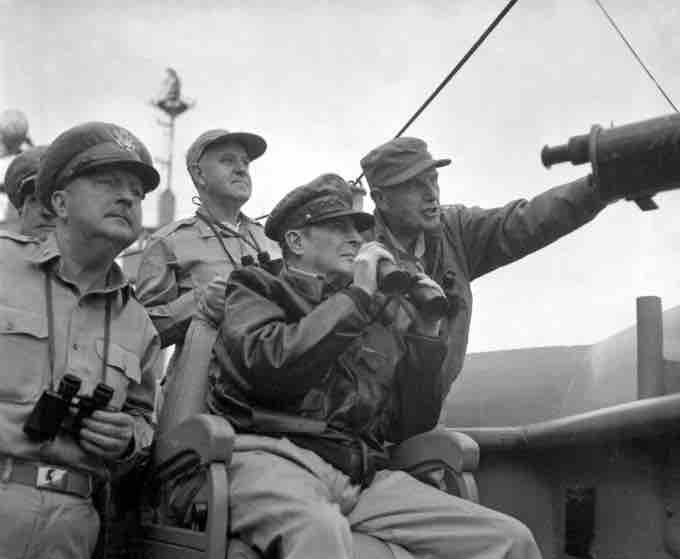Containment and the Korean War
Containment was the major Cold War policy of the United States and its allies to prevent the spread of communism abroad. This policy was a response to a series of moves by the Soviet Union to enlarge communist influence in Eastern Europe, China, Korea, Africa, and Vietnam. Containment represented a middle-ground position between detente (the easing of strained political relations) and rollback (forcing change in the major policies of a state, usually by replacing its ruling regime). It lets the opponent choose the place and time of any confrontation. During the Cold War it meant intervening to prevent the spread of Communism to new countries but not attacking nations that were already Communist.
In line with this policy, the U.S. attempted to curb Soviet influence on the Korean Peninsula by occupying the southern part of that area. The area occupied by the U.S. became South Korea, while the other part became North Korea. North Korea soon passed into the control of the Communist Party.
In May, 1949, fighting between North and South Korean troops broke out near the border between the two nations. In an attempt to add South Korea to the Communist World, North Korea invaded South Korea in 1950. The People's Republic of China and the Soviet Union lent their support to North Korea, while the United States did the same to South Korea. On June 25, 1950 a large military force moved across the 38th parallel in the Republic of Korea.
On Saturday, 24 June 1950, U.S. Secretary of State Dean Acheson informed President Truman by telephone, "Mr. President, I have very serious news. The North Koreans have invaded South Korea." Truman and Acheson discussed a U.S. invasion response with defense department principals, who agreed that the United States, was obligated to repel military aggression, paralleling it with Adolf Hitler's aggressions in the 1930s, and said that the mistake of appeasement must not be repeated. In his autobiography, President Truman acknowledged that fighting the invasion was essential to the American goal of the global containment of communism as outlined in the National Security Council Report 68 (NSC-68). The Korean War was the first militarized instance of containment, as U.S. and South Korea fought against communist North Korea.
On June 27, 1950 the United Nations security Council first adopted a ceasefire resolution. When the United Nations Security Council voted to aid South Korea in stopping North Korean aggression, the United States agreed to send troops to the Korean Peninsula. General Douglas MacArthur was given the command of UN troops in Korea. The United States agreed to send troops over on June 30 along with increasing aid to the French fight against Communists rebels in Indochina. MacArthur was placed in command on July 8. At the beginning the U.S. troops were lacking training and were out of shape. In the first few weeks of fighting the U.S. troops were pushed back to a defensive perimeter at Pusan.

Incheon
US success at Incheon encouraged UN and US forces to pursue a policy of rollback in Korea. This photograph depicts General MacArthur observing the Incheon Landing.
As a counter-offensive, MacArther launched the Inchon Landing, a decisive victory and strategic reversal in favor of the United Nations.he success of the Inchon landing inspired the U.S. and the United Nations to adopt a rollback strategy to overthrow the Communist North Korean regime, thus allowing nationwide elections under U.N. auspices. General Douglas MacArthur then advanced across the 38th parallel into North Korea. The Chinese then sent in a large army and defeated the U.N. forces, pushing them below the 38th parallel. Although the Chinese had been planning to intervene for months, this action was interpreted by Truman's supporters as a response to U.S. forces crossing the 38th parallel. This interpretation allowed the episode to be used to confirm the wisdom of containment doctrine as opposed to rollback. The Communists were later pushed back, to around the original border. Truman blamed MacArthur's focus on victory and adopted a "limited war" policy. His focus shifted to negotiating a settlement, which was finally reached in 1953. For his part, MacArthur denounced Truman's "no-win policy."
Chinese forces enter Korea
Chinese forces crossed the Yalu River and joined the Korean War. Chinese entrance into the War prolonged the conflict, and increased tensions between the U.S. and China.
While not directly committing forces to the conflict, the Soviet Union provided material aid to both the North Korean and Chinese armies. The fighting ended on 27 July 1953, when the armistice agreement was signed. The agreement restored the border between the Koreas near the 38th Parallel and created the Korean Demilitarized Zone (DMZ), a 2.5-mile-wide fortified buffer zone between the two Korean nations. Minor incidents still continue today.